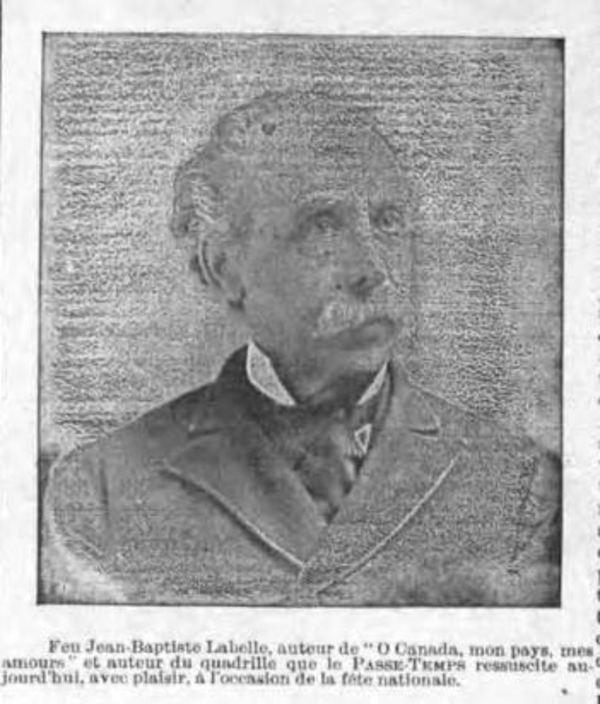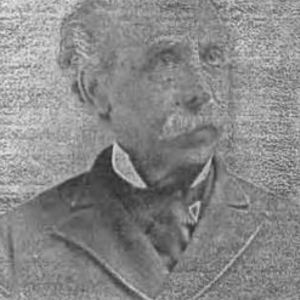
Source: Link
LABELLE, JEAN-BAPTISTE, musician, composer, teacher, and merchant; b. in September 1825 in Burlington, Vt, and baptized 13 Nov. 1825 in Montreal, son of Jean-Baptiste Labelle, a cartwright, and Marie Alain; m. first 9 July 1849 Sophie Porlier, a singer, in Chambly, Lower Canada; m. secondly 23 Oct. 1860 Marie-Eugénie-Henriette Morin at Quebec; d. 9 Sept. 1898 in Montreal and was survived by four sons and five daughters.
Jean-Baptiste Labelle received his musical training from renowned teachers: Joseph Bossu, dit Lyonnais, of Quebec, Leopold von Meyer, an Austrian pianist who toured North America between 1845 and 1847, and Sigismund Thalberg, a German or Austrian virtuoso with whom he took piano lessons in Boston from December 1856 to January 1867. He may also have studied in Europe some time between December 1856 and June 1857. The teaching of Meyer and Thalberg influenced his career as a pianist and composer. Labelle was probably the first Canadian soloist to perform abroad, on a concert tour of various cities in the United States and South America in October 1857. Some of his concert programs after 1856 include a piano fantasia of his own composition, which was probably an arrangement of music from operas by Bellini, Donizetti, and others, designed to arouse the emotions generally associated with the art of operatic singing.
Labelle’s preference for dramatic music is reflected as well in the programs of concerts in which he performed as accompanist for his wife Sophie Porlier, as well as for other singers, particularly between 1856 and 1860. It can also be seen in at least three cantatas he composed: La confédération, La conversion d’un pêcheur . . . , and La croisade canadienne. But Labelle also made his mark as a conductor. In 1861, for example, he conducted the Société Philharmonique Canadienne of Montreal, a group of 29 amateur and professional musicians that attracted considerable public attention on account of its size and classical training. On a more modest scale, but none the less important for the cultural life of the time, Labelle participated in many musical events of a patriotic nature, as well as benefit concerts.
In the field of sacred music he played a significant role as church organist from the age of 15 at Boucherville, at Chambly from 1846 to 1849, and at Notre-Dame in Montreal from September 1849 until 1891. Nothing is known of his training in church music except that he was a disciple of Vincent Novello, an English composer and publisher of Italian descent, whose sacred music he helped to make more widely known in Canada and whom he acknowledged as a model in his own composing. Labelle’s work Répertoire de l’organiste, published in 1851 and reissued in at least ten further printings, displays little originality in musical composition. But his intention of making accompaniment for masses, sequences, hymns, psalms, and motets more uniform was a laudable undertaking and probably ahead of its time. His second collection, Les échos de Notre-Dame, met with no success. The first edition of six “Motets . . . for the Benediction of the Blessed Sacrament,” which was published in 1887 with the promise of a sequel if it were well received, was also the last.
Like most professional musicians in the 19th century, Labelle was in demand as a music teacher. He taught at various stages in his career at the Petit Séminaire de Montréal, the Collège Sainte-Marie, the École Normale Jacques-Cartier, the Villa Maria and Mont-Sainte-Marie boarding-schools, the convent of Sainte-Anne in Lachine, and, towards the end of his life, the Collège du Mont-Saint-Louis. One obituary mentioned that he was “an extremely dedicated teacher.”
Despite the number and importance of the positions he held, Labelle’s income was probably not adequate to support his large family and to allow him to devote himself to composing anything except utilitarian or commissioned works. This doubtless explains why he became involved in selling pianos in 1855 and then in 1865 started Labelle et Rodier, which was located at 247 Rue Notre-Dame and specialized in the sale of pianos and sheet music. The firm seems to have disappeared around 1867.
Jean-Baptiste Labelle’s career illustrates well the demands on a professional musician in the latter half of the 19th century in Montreal, where proficiency, versatility, and dedication were all essential. Blessed with talent saluted by nearly 30 of Montreal’s best-known amateur and professional musicians at a benefit for him in 1857, Labelle was apparently highly regarded for more than three decades as a performer, teacher, expert on organs and pianos, and composer. The relative abundance of his compositions attests to his mastery of the art of music, but his creativity was confined within structures and forms that did little to foster it. His religious music opened no new vistas in Catholic liturgical music, which had not crystallized along clearly defined lines in the 19th century. His secular music certainly displays the ardent patriotism that was typical of many intellectuals of the time, but it was written for specific occasions and is conventional in style. Perhaps, along with men such as Charles-Gustave Smith, Paul Letondal, Moïse Saucier, Romain-Octave Pelletier*, and Guillaume Couture*, Labelle made his most significant contribution by actively participating in a general effort in Canada to raise the level of teaching in music. For this role he was eminently suited because of his gifts and his training.
Jean-Baptiste Labelle is the author of some 60 compositions. His best-known works and pieces in the chronological order of their composition or first publication are: . . . ‘“Marche canadienne’ pour cornet et piano,” Album littéraire et musical de la Rev. canadienne (Montréal), 1846: 28; Répertoire de l’organiste, ou recueil de chant-grégorien à l’usage des églises du Canada (Montréal, [1851]); the music for “Souhaits du Nouvel An,” for which Joseph Lenoir*, dit Rolland, wrote the lyrics, in Le Moniteur canadien (Montréal), 3 janv. 1852; “Avant tout je suis Canadien,” in Le chansonnier des collèges mis en musique (3e éd., Québec, 1860), 7–9; O Canada, mon pays, mes amours, a patriotic song written by Sir George-Étienne Cartier* which forms part of the cantata La confédération and which went through numerous editions after its first publication some time before 1868; the music for La confédération, with words by Auguste Achintre* (s.l., [1868]); the music for La conversion d’un pêcheur; opérette canadienne, lyrics by Elzéar Labelle (Montréal, s.d.); the music for “Chant des zouaves canadiens, 1870,” lyrics by Alphonse Bellemare, L’Album musical (Montréal), décembre 1881; the music for “Ma fiancée,” a sentimental ballad written by Elzéar Labelle and published in his book Mes rimes (Québec, 1876), 95–96; the music for “Chansons du Jour de l’An,” with words by Benjamin Sulte*, Album de la Minerve (Montréal), 1 (1872): 31–32; the music for two patriotic songs written for the 24th of June: “La Saint-Jean Baptiste,” using words by Elzéar Labelle, and “O Canada, vois sur ces rives,” by Eustache Prud’homme, in Rev. canadienne, 11 (1874): 455–57; “Rien n’est si beau que mon couvent,” Le Canada musical (Montréal), 1er avril 1878; La croisade canadienne (s.l., [1886]); the music for Le retour du zouave!, with words by Alphonse Bellemare (s.l.n.d.); Les échos de Notre-Dame (Montréal, [1887]); ‘“Quadrille national canadien’ extrait des chants canadiens les plus populaires,” Le Passe-Temps (Montréal), 17 juin 1916: 230–34. The compilation Les chansons les plus populaires has also been attributed to Labelle. A portrait of him has been reproduced in various works including Le Passe-Temps, 17 juin 1916.
ANQ-M, CE1-39, 9 juill. 1849; CE1-51, 13 nov. 1825, 13 sept. 1898. ANQ-Q, CE1-1, 23 oct. 1860. L’Art musical (Montréal), avril, septembre 1898. Les Beaux-Arts (Montréal), 1er avril, 1er mai 1863; 25 avril 1864. Le Canada musical, 1er mars, 1er mai, 1er oct. 1878; 1er févr., 1er août 1879. Journal de l’Instruction publique (Québec et Montréal), 1 (1857); 3 (1860). La Minerve, 25 oct., 3 déc. 1849; 31 déc. 1853; 2 févr., 26 mars, 20 déc. 1856; 31 janv., 11 févr., 18, 21, 25 nov. 1857; 19, 23 juin, 30 oct., 24 déc 1858; 24 janv. 1860; 24 juin 1874. Le Passe-Temps, 1er oct. 1898. La Presse, 10 sept. 1898. Catalogue of Canadian composers, ed. Helmut Kallmann (2nd ed., Toronto, 1952; repr. St Clair Shores, Mich., 1972). Chansons sur textes français II, Lucien Poirier, édit. (Ottawa, 1987), xxxvi, xxxix, xlii, 26–27, 52–53, 110–11. Dictionnaire biographique des musiciens canadiens (2e éd., Lachine, Qué., 1935), 139–40. DOLQ, 1: 492–93. Encyclopedia of music in Canada (Kallmann et al.). A.-G. Lyonnais, Généalogie de la famille Lyonnais en Canada (Ottawa, 1901), 49. Montreal directory, 1852–98. Musicians in Canada: a bio-bibliographical finding list, ed. K. M. Toomey and S. C. Willis (Ottawa, 1981), 59. Willy Amtmann, La musique au Québec, 1600–1875, Michelle Pharand, trad. (Montréal, 1976), 385–86. Maria Calderisi, Music publishing in the Canadas, 1800–1867 (Ottawa, 1981), 16. Adélard Desrosiers, Histoire de la musique, de l’antiquité à nos jours (Montréal, 1939), 70, 80. Clifford Ford, Canada’s music: an historical survey (Agincourt [Toronto], 1982), 41. Helmut Kallmann, “Historical background,” Music in Canada ([Toronto], 1955), 23; A history of music in Canada, 1534–1914 (Toronto and London, 1960), 96–97, 104, 138, 238. Labarrère-Paulé, Les instituteurs laiques, 207. M. P. Lagacé, Les chants d’église en usage dans la province eccléstastique de Québec . . . (Paris, [1860]). Jeanne d’Arc Lortie, La poésie nationaliste au Canada français (1606–1867) (Québec, 1975), 282, 287. L.-P. Morin, Papiers de musique (Montréal, 1930), 74. [C.-]G. Smith, Compte-rendu de la réception de l’orgue de la chapelle wesleyenne . . . (Montréal, 1861), 13. John Hare, “La cantate de la confédération,” Biblio. Soc. of Canada, Papers (Toronto), 5 (1966): 95–103. O [-M.-H.] Lapalice, “Les organistes et maîtres de musique à Notre-Dame de Montréal,” BRH, 25 (1919): 247. Réal Vautour, “Trois quadrilles canadiens du 3e quart du XIXe siècle,” Assoc. pour l’avancement de la recherche en musique du Québec, Cahiers (Montréal et Québec), 4 (1984): 33–45.
Cite This Article
Lucien Poirier, “LABELLE, JEAN-BAPTISTE,” in Dictionary of Canadian Biography, vol. 12, University of Toronto/Université Laval, 2003–, accessed January 3, 2025, https://www.biographi.ca/en/bio/labelle_jean_baptiste_12E.html.
The citation above shows the format for footnotes and endnotes according to the Chicago manual of style (16th edition). Information to be used in other citation formats:
| Permalink: | https://www.biographi.ca/en/bio/labelle_jean_baptiste_12E.html |
| Author of Article: | Lucien Poirier |
| Title of Article: | LABELLE, JEAN-BAPTISTE |
| Publication Name: | Dictionary of Canadian Biography, vol. 12 |
| Publisher: | University of Toronto/Université Laval |
| Year of publication: | 1990 |
| Year of revision: | 1990 |
| Access Date: | January 3, 2025 |



